Value addition and processing of commodities
Honey Processing
Honey is a product obtained from bees. Honey processing involves removal of wax or any other foreign materials, packaging and labelling. Honey is important for the human body because it contains nutrients and also has other health benefits. Beeswax that is another product obtained from honey is used as a polish for wood, and metals. It can be mixed with other ingredients to form varieties of polish.
Honey extractors
- These can be either electrically or manually driven machines which operate on the principle of centrifugal force.
- Extractors vary in size ranging from small two- frame units to big ones holding up to 85 frames.
- Manual extractors are equipped with either a hand crank or a bicycle chain while the electrical ones are motor driven.
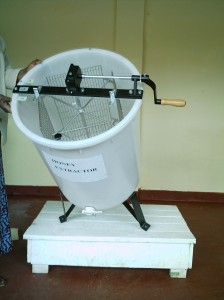
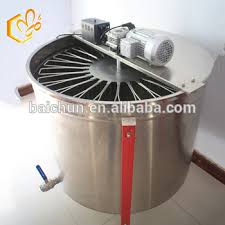
Hand crank manual extractor and electrtical honey extractor
Simple Straining Method:
This method is suitable for freshly harvested honey.
- Uncap (remove the thin wax layer that seals the honey cells) the honey and allow it to pass through a straining cloth or net into a clean and dry suitable container.
- Fold the straining net (nylon mostly) once, to form two layers and tie over the mouth of the container.
- Use a wide mouth container to collect the strained honey
- Allow the liquid honey to settle overnight.
- Remove the scum (cream) from the surface of the honey using a spoon before the honey is packed.
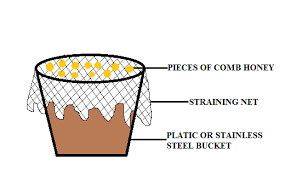
Figure 3: simple straining method
Water Bath Method:
- This is also referred to as batch processing. This method is suitable for semi-processed honey which has been stored for some time and possibly crystallised.
- Honey is first heated in a water-bath (indirect heating), up to about 45°C – 50°C.
- Honey is heated to facilitate both straining and fast handling, secondly, to destroy yeast that may be present and may cause fermentation particularly if the moisture content is above 17%.
- The indirect heating method involves the use of two ‘sufurias’; the smaller one containing honey is placed inside a bigger one containing some water and a piece of wood placed at the bottom so that the smaller one does not touch the bottom of the bigger sufuria.
- The honey that is being warmed must be stirred to distribute the heat evenly.
- A straining cloth is then folded twice (forms four layers) and firmly tied onto a clean, dry suitable container as in the case of simple straining method above.
- Once all the warm honey has passed through the cloth, cover the bucket with a lid, and allow it to settle for a minimum of 3 days to allow the scum to collect at the top of the strained honey.
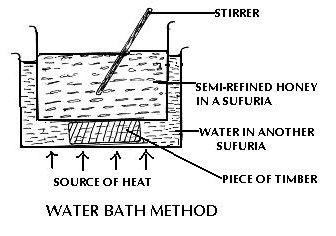
Bulk Processing:
- It is used for large quantities of honey.
- In this method, honey is made to flow through a series of sieves of various sizes.
- The sieves are arranged in a concentric form, the finest mesh being on the outside and coarser on the inside.
- The semi-refined honey is heated to 45-50°C in a sump tank and then flows by gravity through the sieves usually referred to as strainers; into a settling tank and is left there for at least 3 days.
- The scum collects on top of the strained honey, it is then removed and the honey packed.
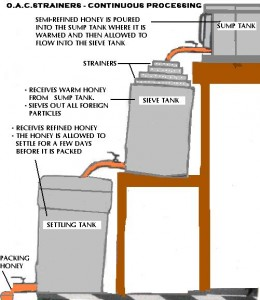
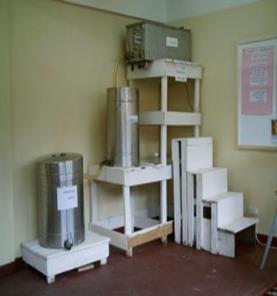
Bulk processing of honey
Pressing Method:
- Honey is forced out of the comb by pressing it out using a honey press.
- This should be done as soon as possible after harvesting.
- After pressing out the honey, it is then warmed using a water-bath and strained.
Honey Blending
- Honey from different sources will have different characteristics.
- In order to bring uniformity, different honeys have to be blended.
- This involves mixing the honeys during processing so that the final product becomes homogenous and have the same physical and chemical properties.
Processing bees wax
- Wrap empty honey combs in a cheese cloth
- Put water in a pot and heat until the water starts simmering
- Put the wrapped honey combs in the simmering water and bring to boil
- As the water boils the honeycomb will melt and the water will turn yellow
- Once the wax is rendered pour it into a container and leave it to cool and harden
- The hardened wax needs further cleaning and this is done by melting the wax again by boiling and passing it through a filter

